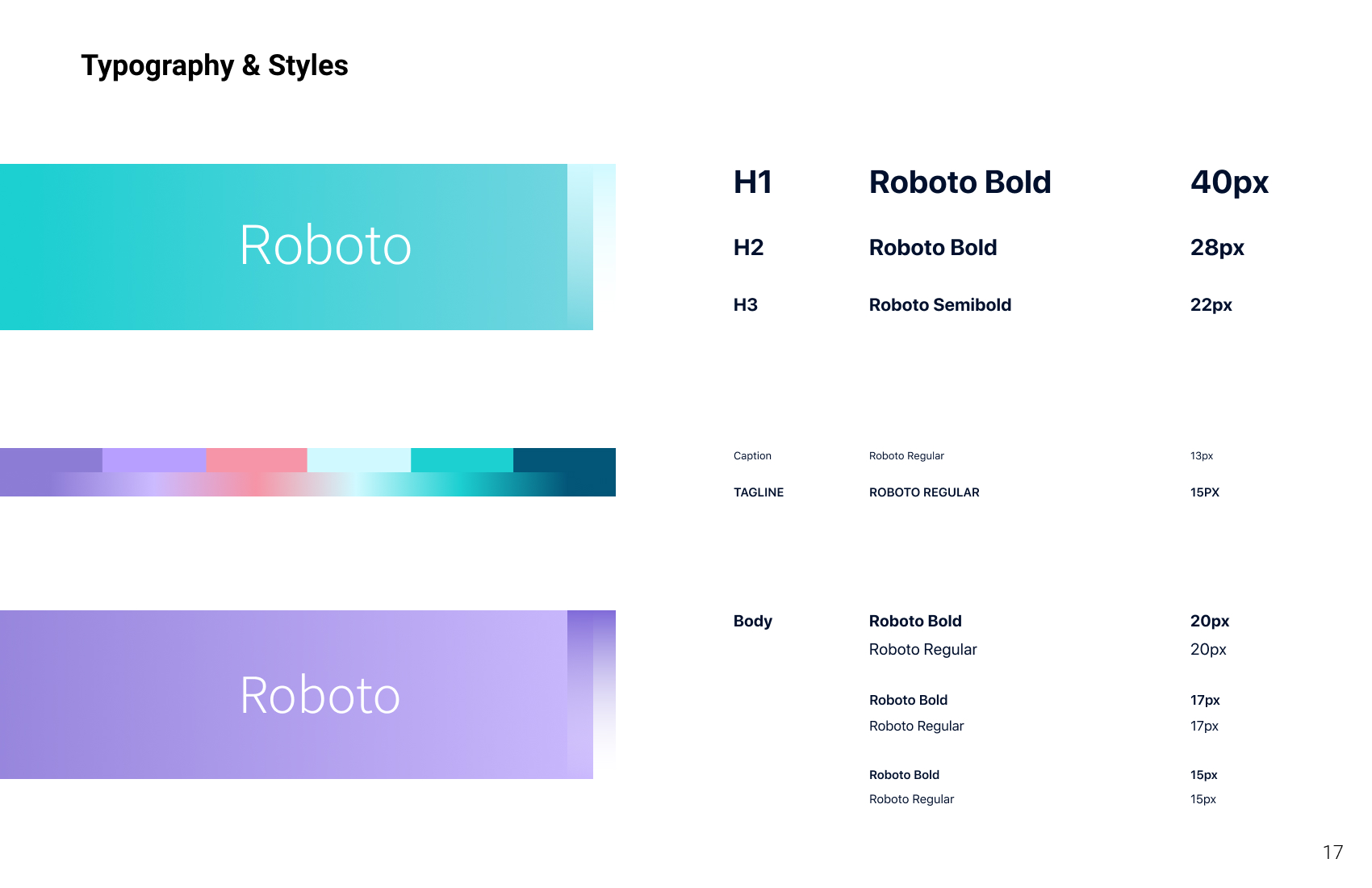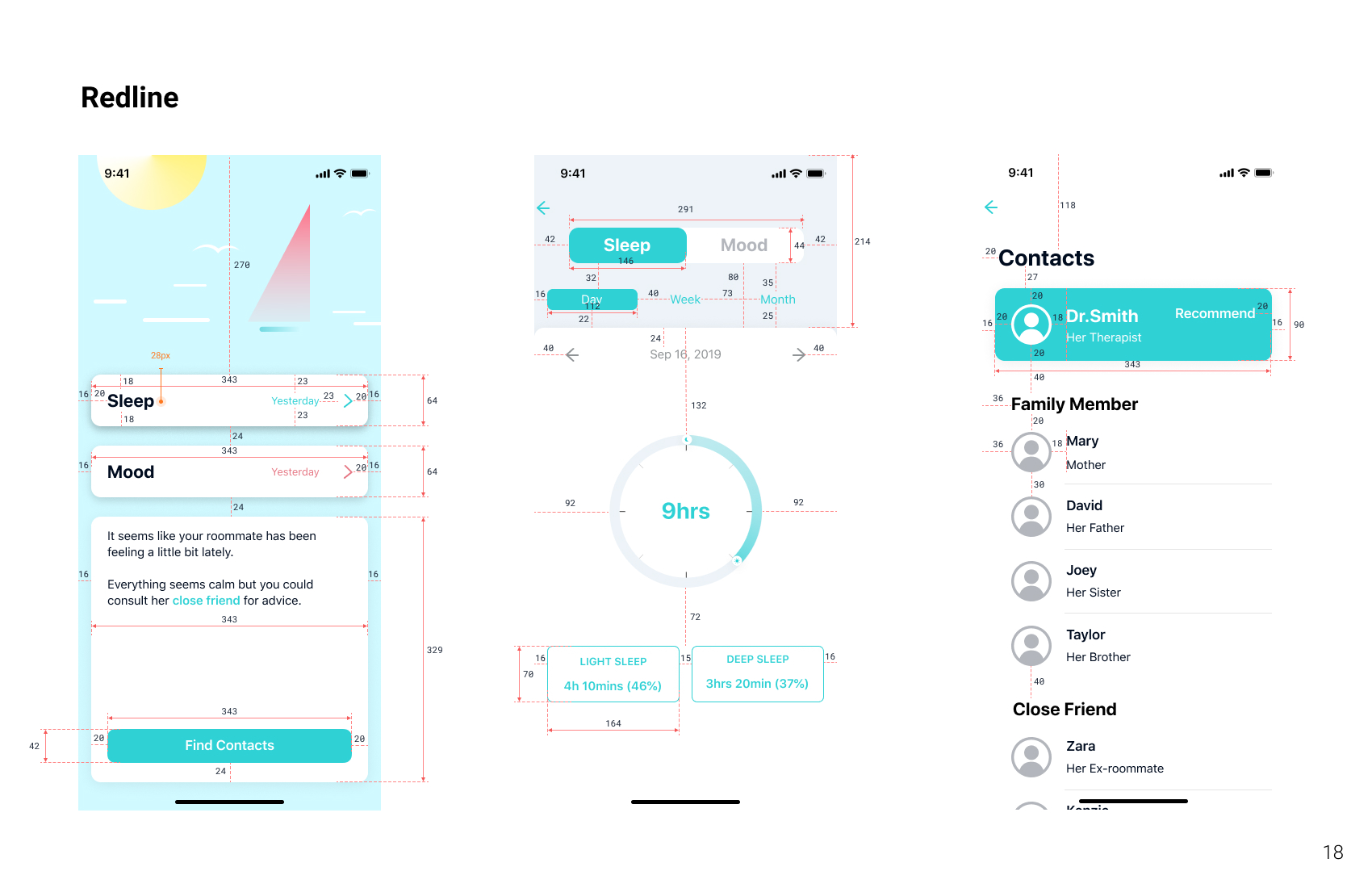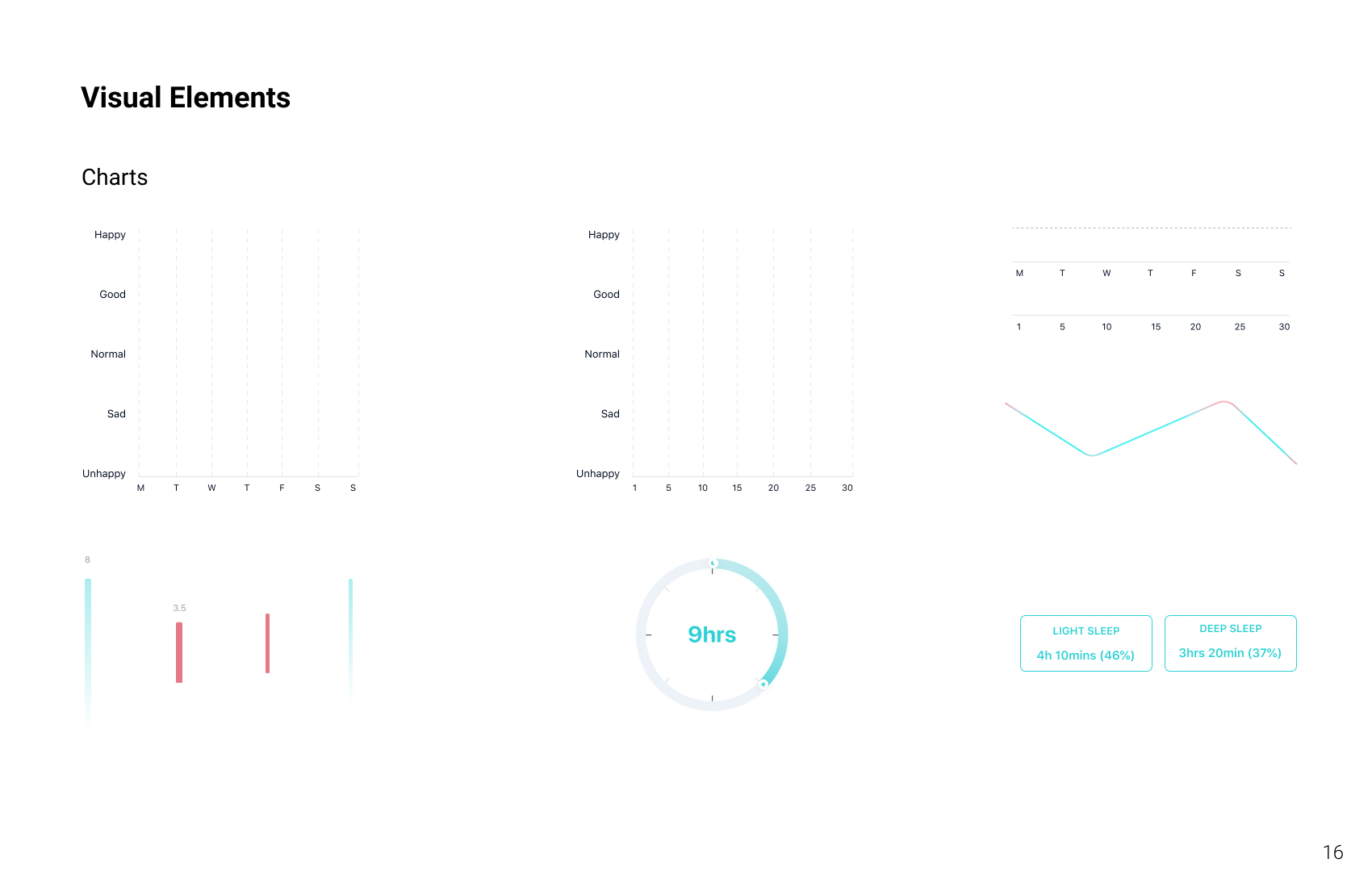Overview
Sail is a design concept developed over the course of 3 months. It consists of a wearable device and a phone app for bipolar disorder patients to document their symptoms. The visualization system will encode their health info into visual metaphor to helps their roommates validate their concerns and connect them with the patient's larger support network in case of an emergency.
Team Members:
3 Designers - Harri Lin, Zara Abraham, Xiaoshi Dai
My Role:
Led UX design, interaction design, motion graphic and visual concept.
Duration:
Sept 2019 - Dec 2020 (3 months)
Tools:
Figma, Sketch, Illustrator, Maya, After Effect, Premiere
Design Challenge:
How might we support roommates of people with Bipolar Disorder, and help them to be better allies to the patient?
People with bipolar disorder experience high and low moods—known as Mania and Depression. Both of my teammates used to live with people who suffer from bipolar disorder and it really affected every aspect of their experience living together. For this project, we want to help patients with bipolar disorder find success living independently and support the people they live with.
Feature Highlight
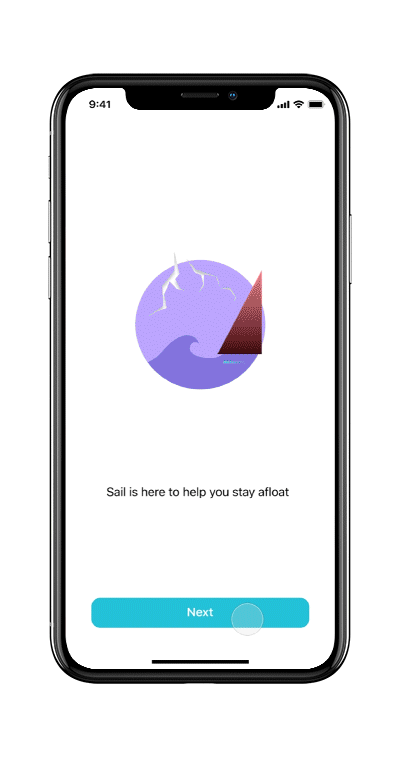
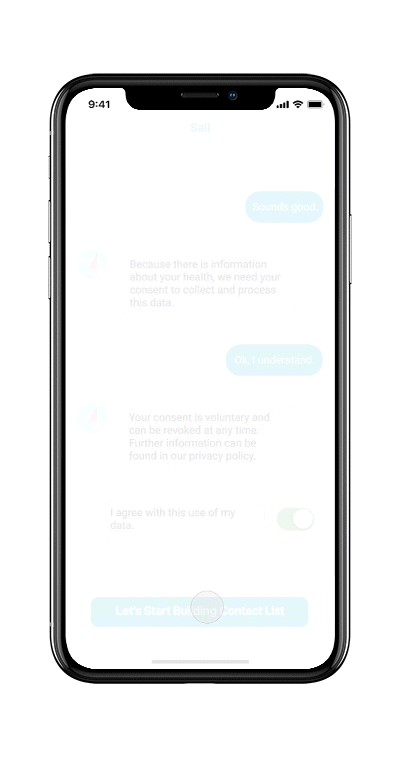
On-Boarding & Set-Up
Create Contact Lists
User will finish the consent process through an approachable chatbot to avoid information bombards. Patients will create the support network list by importing from the phone’s default contacts.
Related research insights: Roommates of bipolar disorder patients aren’t aware when patients are having an episode. They want to be on the same page with others on the patient's support network.
Track Stability
Track Health Data Effortlessly
Patients with bipolar disorder can log their daily emotions via a wearable bracelet that also tracks their sleep. The e-ink on the surface will visualize the patient's health data to improve the self-awareness of mood status.
Related Research Insights: Patients with bipolar disorder desire to track their key indicators of mood, emotional state and sleep, as part of their cognitive therapy.
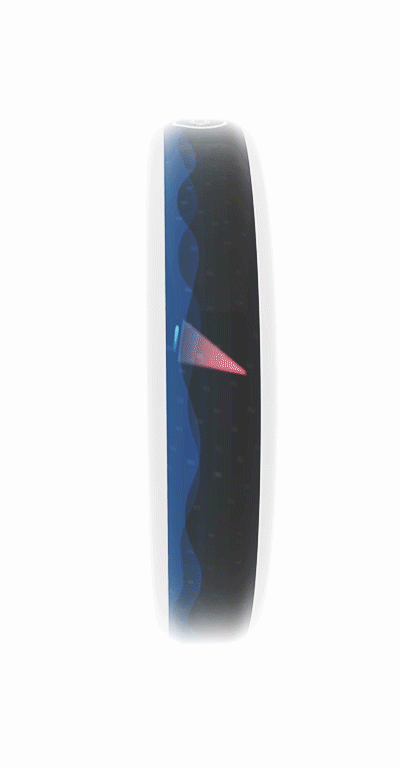
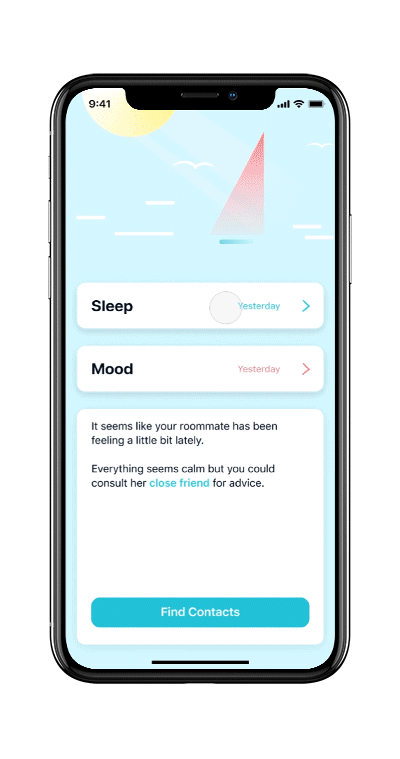
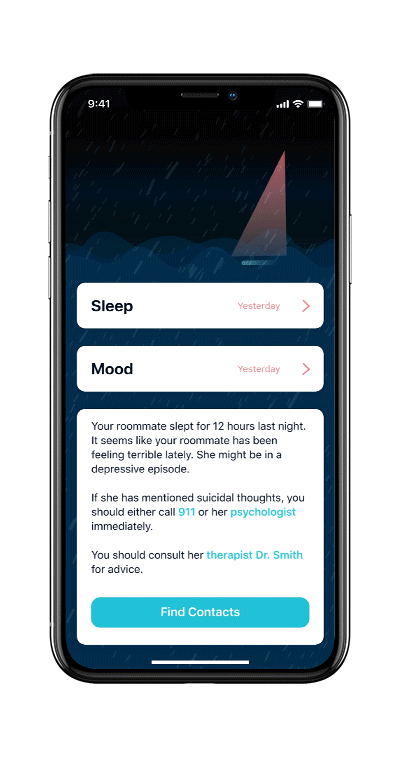
Data Visualization
Encode Health Data with Visual Metaphor
The wearable will sync the data to the app and visualize it with our special visual system to help the roommate better perceive the stability of the patient and validate their assumptions as well as gauge the severity of the situation.
Related Research Insights: Although roommates want to know patient’s health conditions and stability, roommates prefer to see the succinct summary instead of a detailed explanation of the patient’s health data.
Minimize Burden
Coordinate Support
The system connects roommates with patients' families, medical teams, and support networks which is shared by the patient. This allows roommates to reach out to more people in a severe situation to share the responsibility to minimize the burden on their shoulders.
Related Research Insights: Roommates hope to join the patient’s support system to reach out for future assistance and share the responsibility to navigate through some complex situations.
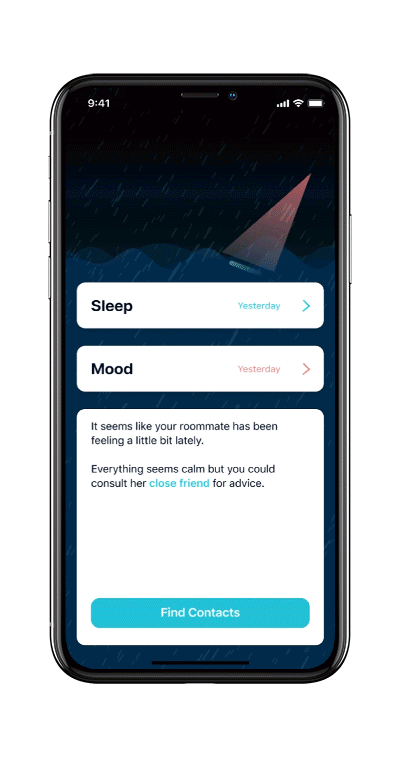
Project Process
As the person who takes the management role, I divided the time frame into two parts: research (4 weeks) +design (8 weeks) at the beginning to help the team align with the plan and milestones.
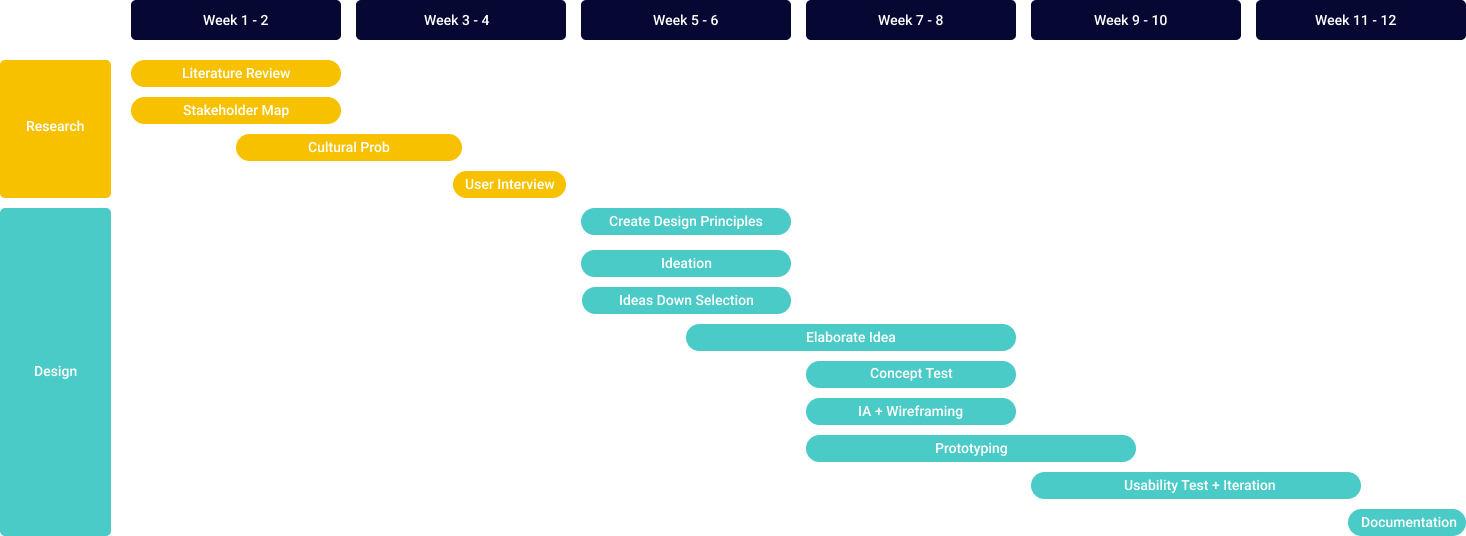
Why We Did This Project
A Personal Note
Bipolar disorder is a mental illness that causes dramatic shifts in a person’s mood, energy and ability to think clearly. It can be particularly dangerous because patients aren’t aware when they are having an episode.
Actually, this disorder is much more prevalent than we think. 2.6% of American adults have Bipolar Disorder, which equals 6.1 million people each year. Both of my teammates used to live with people who suffer from bipolar disorder, and it affected every aspect of their experience living together. We hope to help people with bipolar disorder and save them at a critical moment. To better understand bipolar disorder and identify some design opportunities, we conducted secondary research, literature review, cultural prob and semi-structured interview.

Research Methodology
Literatual Review
Stakholder Mapping
Cultural Probe
User Interview
SME Interview
Competitive Analysis
Secondary Research Insights
On-boarding Ourself
To better understand what is bipolar disorder, we conducted secondary research in the form of literature reviews, documentary movies, online blogs, and community forums. Our team realized this mental illness is more several than we thought.
- Bipolar disorder is a lifelong illness. Episodes of mania and depression typically come back over time.
- 15%-17% of people with bipolar disorder take their own lives in a given year.

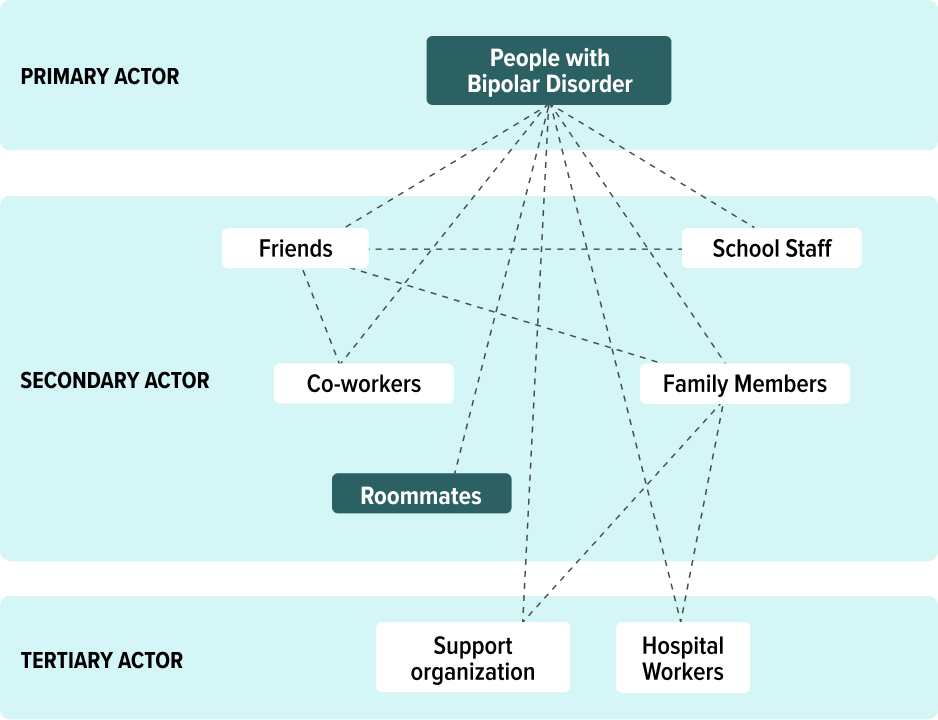
This is the stakeholder map we created
People Around BD Patients
Most people get diagnosed with bipolar disorder in their early 20s. By that time, they just finished college and about to enter society to start their 1st job. They might be far from their family members and have a hard time to manage their symptoms through medication and therapies.
When we put together the stakeholder map, we realized that Roommate is a secondary actor with the closest physical proximity and connection to the primary actor but virtually no connection to any other actors.
Learn the Dynamic Between BD Patient & Roommate
We decided to put our focus on roommates. We team spent the entire week recruiting participants in the local area but cannot find any. So we pivoted to use a cultural probe with participants in a remote setting. In the probe, we asked them about their trivia and small things in their daily life and hoped to learn how it feels like living with bipolar disorder patients to gain insight into the overall relationship of both of them.
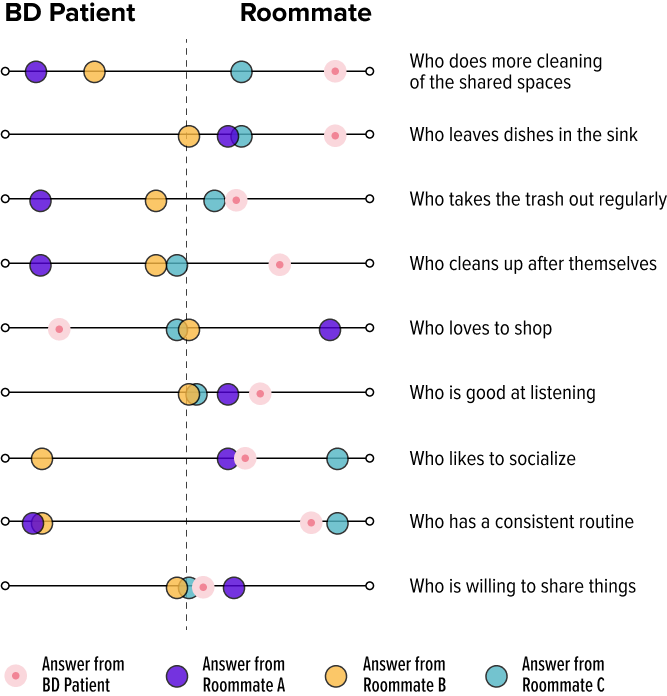
Here are responses we collected of our cultural probe.
User Interview Insights
Deep Dive into their Relationship
Based on the cultural prob responses, we then conduct a remote interview with 2 roommates to deep dive into their relationship. The following are a few insights we summarized from primary research.
Being roommates with Bipolar Disorder patients comes with caregiving responsibilities, most roommates are willing to take on a certain level of these responsibilities.
“we had to step up and be her family.”
“It was an easy transition.”
“I thought ‘this is hard, I don't know what to do’ not “this is hard, I don't want to do it.”
Roommates want to be connected with patients' family, friends, medical team and support network to better support the patient and to feel supported themselves.
“Being able to communicate with her support network, to be able to communicate with the other people in her life. I wish we could have been more on the same team with her support network.”
“I wish we had a schedule of who is gonna watch her, we didn't have a way to communicate with other people in her life.”
Roommates get most of their information about Bipolar Disorder from the patient.
“We got most of our information from her directly.”
“It was mostly through talking to her and what her experiences were like.
Define User Needs
Desired Outcome
Based on what we learned from secondary research and user interview, we came up with 4 design principles or what we called design values as our project goals to measure our ideas and work for the rest of the project.
1. Maintain a Sense of Control
Help roommate validate their concerns and confusion when they notice symptom signs and assume something is going wrong
3. Minimize Burden
Instill confidence in roommates with recommendations that they may need at a critical moment, with aid from the others.
2. Coordinate Support
Help roommates stay on the same page with other people in the patient’s support network to better support patients and roommates.
4. Ethical Tracking
Being aware of data privacy and HIPPA compliance. Make sure the information between BD patients and roommates are stored in a secure place.
Design Concept
Ideation & Down-Selection
After identifying the major pain points and needs, we used braiding and 8x8’s methods to brainstorm over 90 different ideas to answer our challenges with the constrain of our design principles. By using our design principles and dot voting, we down-selected to 3 potential concepts from 90 ideas. However, because of the time limitation and technical constraints, we decided to move on with 2 of them and combine them together.
Two Final Ideas
1. Track and Visualize Data (benefit patients)
We want to create a tracking device to ethically track and document the patient’s medication, emotions, sleeping, etc. and then visualize the data in a way that suits the roommate’s needs.
2. Coordinate Support (benefit roommates)
We want to create a tool that will create a database of the patient’s support system for the roommate to reach out for assistance and share the responsibility.

This is how we used design principles and dot voting to down-select final concepts from 90 ideas
Visualization of How System Works
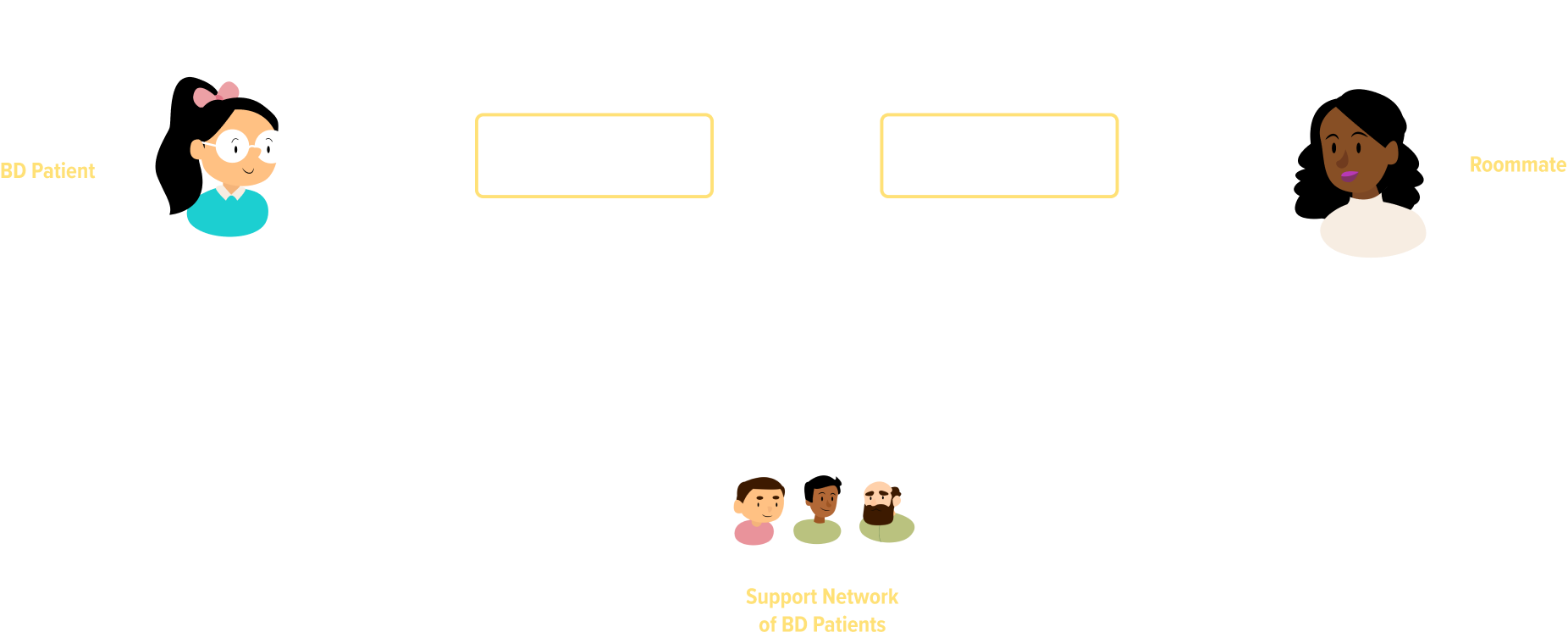
Detailed User Journey

Information Architecture

Initial Flows & Wireframes
I led and owned the entire interaction design part. At first, we built lo-fi prototypes to visually represent a high-level overview of our ideas and gave ourselves a quick understanding of user flows and how our users can navigate between different interfaces.
1. On-boarding & Build Contact List
Both roommates and people from the support network need to finished the onboarding process to understand their expected responsibilities and consent to join the contact list so that they can provide help in the future.
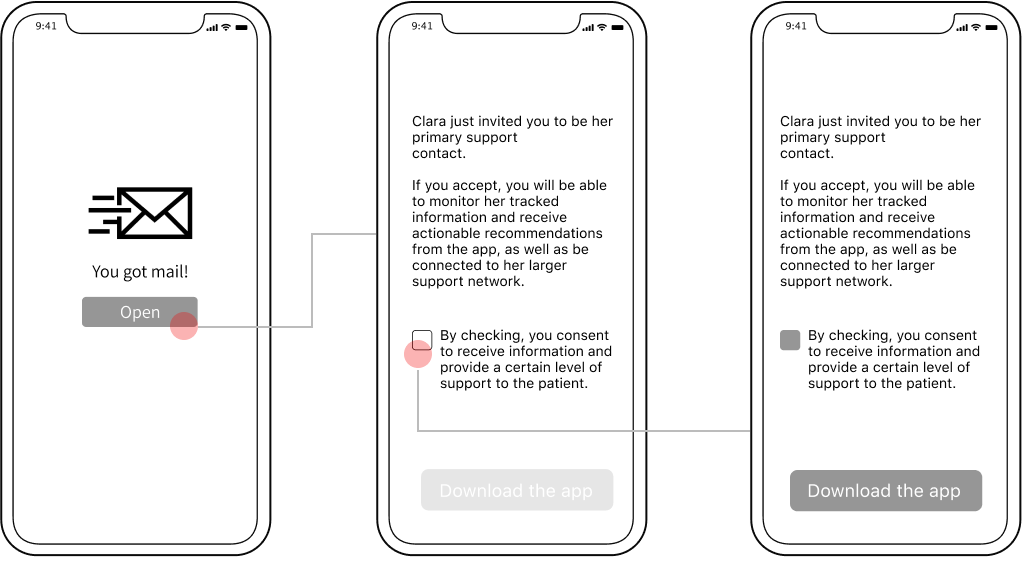
2. Self-document daily mood
Although the device will auto track the sleep data, BD patients need to self-document their daily mood. So we created the flow of logging mood data into the data center.
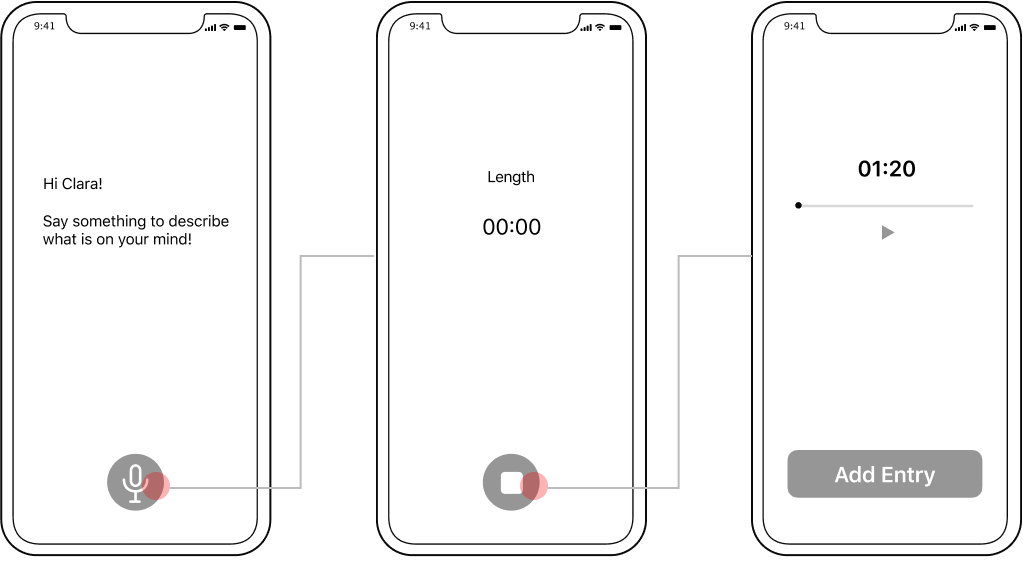
3. Share patient’s health data to roommates
After the device syncing the data with the mobile APP, roommates will be able to have access to patients’ health data to check their stability and validate roommates' concerns.
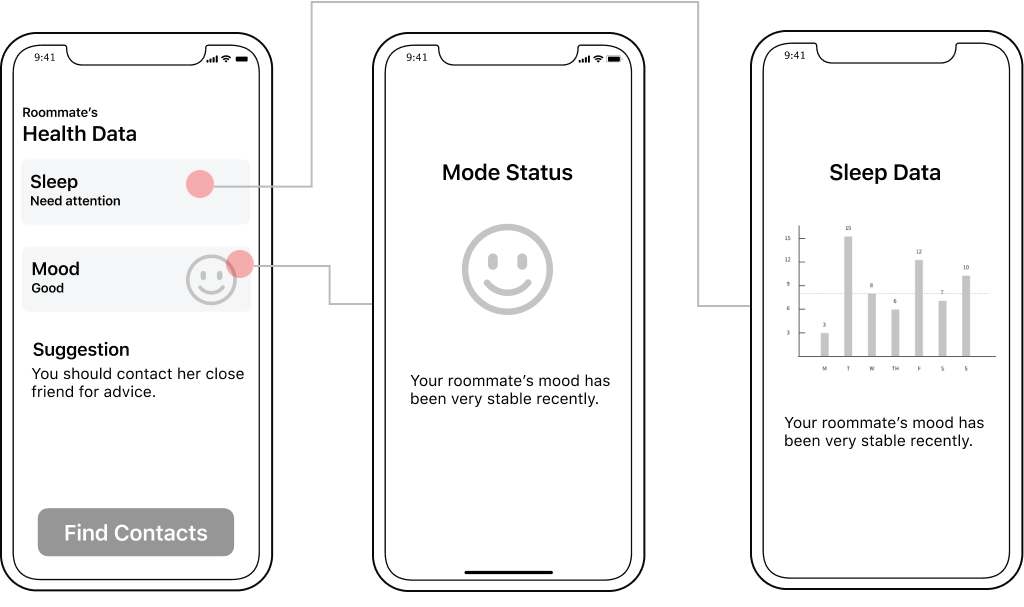
4. Connect people from the support network
If roommate notice something is going off and not sure how to navigate through that situation, he can find a person from a special contact list and reach out for help.
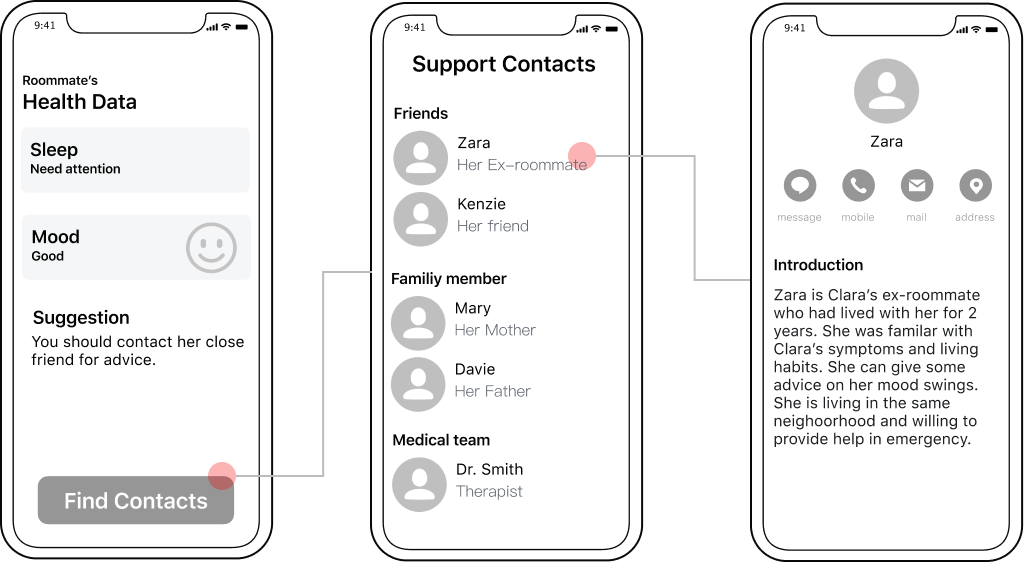
Design & Iterations
Base on identified user flows and lo-fi and mid-fi mockups, I started designing the high-fi UI. I designed several mockups at various fidelities for faster testing and iteration. Between iterations, I increased fidelity while integrating design changes. Early tests focused more on the role of the product while later tests leaned toward the look and feel. The following are a few challenges I faced and how I overcame it with the iterated design.
Challenge 1: Ambiguous Responsibility
Users still get confused about the goal of using the tracking device cause they usually skip the onboarding text. They wish to comprehend the information in an engaging way before consenting to use the product.
Recommendation 1:
I proposed using the chatbot function to break the consent form and all necessary information into multiple parts to make the onboarding process easy and digestible in an engaging way.
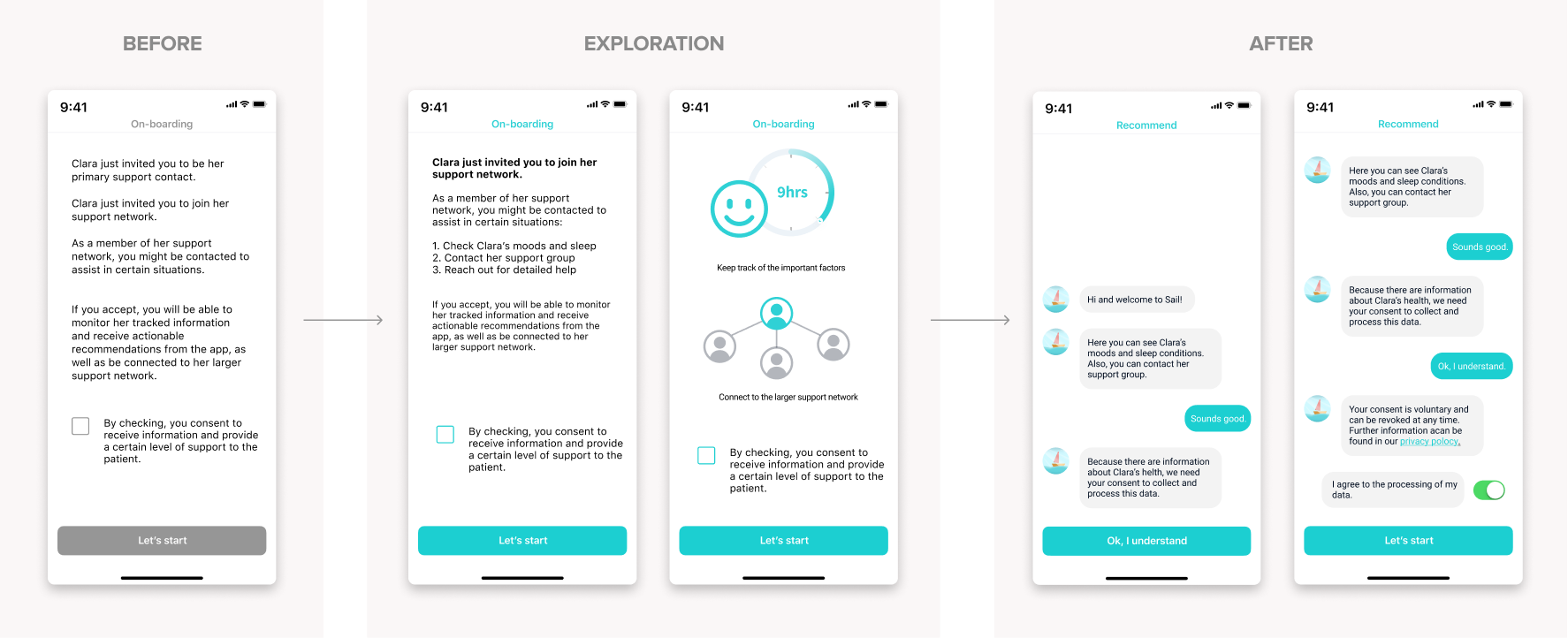
Challenge 2: Choose the Right Device
We thought about using mobile devices like smartwatch and phone app to document the key indicators of bipolar disorder patients' health data: sleep & mood. However, after looking at the competitive landscape, we found out neither of the smartwatch or phone is a good option to document patients' health data.
Recommendation 2:
We decided to customize a wearable specifically for bipolar disorder patients to help them effortlessly track sleep and daily mood:
1. Low energy e-ink surface to visualize the inputted data
2. Long-lasting battery which requires few charging cycles
3. Closing the secure data loop by storing data in our own data center
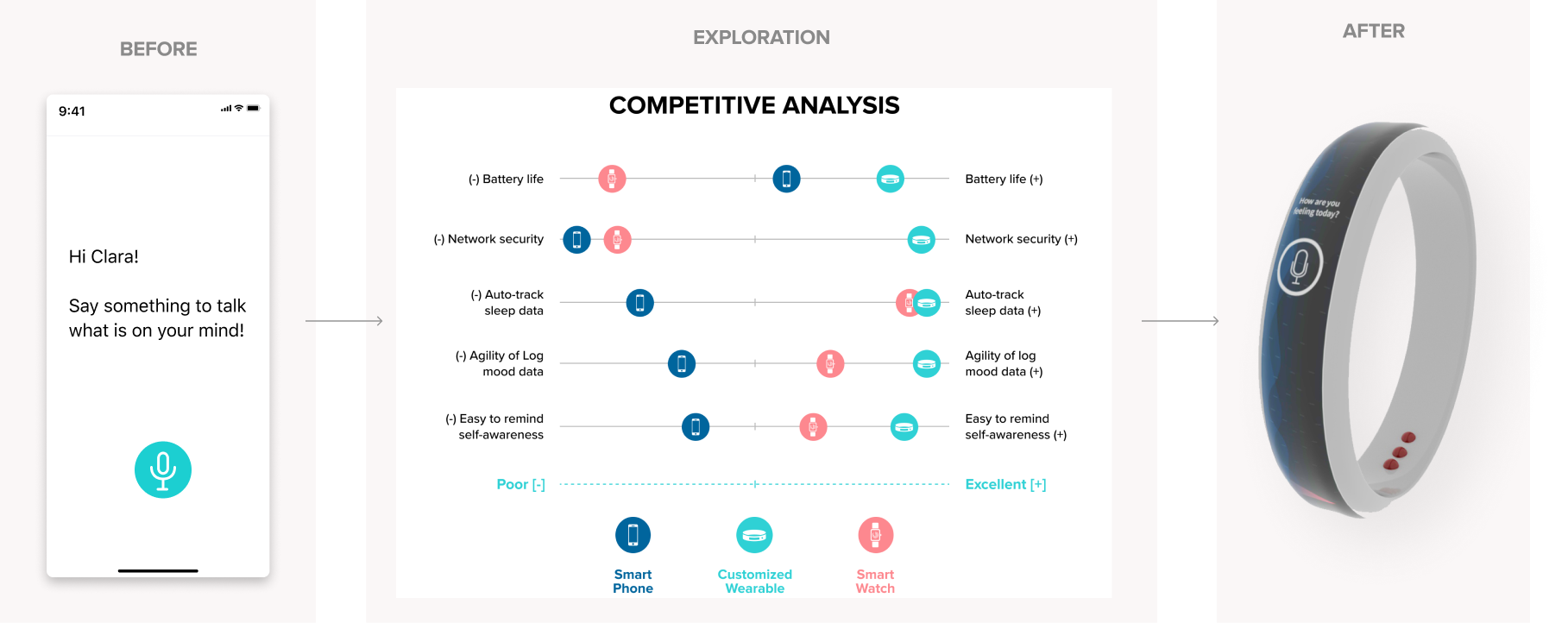
Challenge 3: Special Data Visualization System
Although roommates want to know the patient's health conditions, they think a detailed explanation of the patient's health data is tedious. Besides, our conversation with SME made us realize that people with bipolar disorder wish to see their own health data in a discreet way to reduce social stigma,
When we conduct market research, we found out that there is NO VISUALIZATION SYSTEM currently on the market can provide both:
1. Succinct summary specifically for bipolar disorder
2. Esoteric but comprehensible data visualization
Recommendation 3:
We decided to customize a visual system for bipolar disorder to encode patients' health data in a visual metaphor, which is discreet but easy to understand.
We got inspiration from a short movie called Little Boat. Then I designed all the visual metaphors to represent bipolar disorder patient's health status - In the form of a boat sailing in different weather patterns to represent Depressive episode, Calm Stage and Manic Episode.
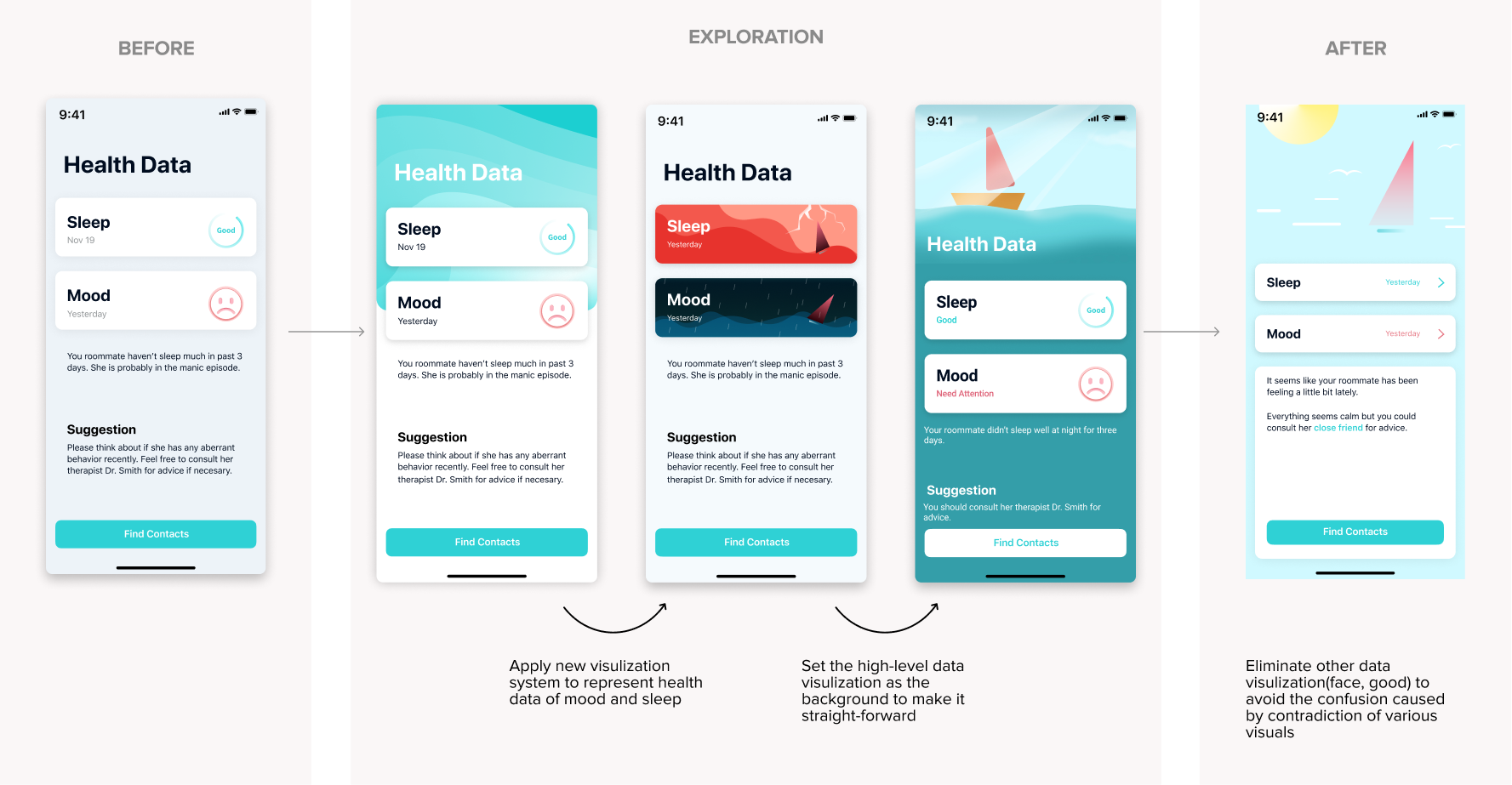
Challenge 4: Creating easy to understand data visualization
We put the detailed health data into the secondary page. However, during usability testing, several participants mentioned that they feel the information visualization is hard to understand.
Recommendation 4:
I tried 10+ different data visualizations and test them with participants. By comparing different visualization methods one-on-one, we found out the best method to show health data.
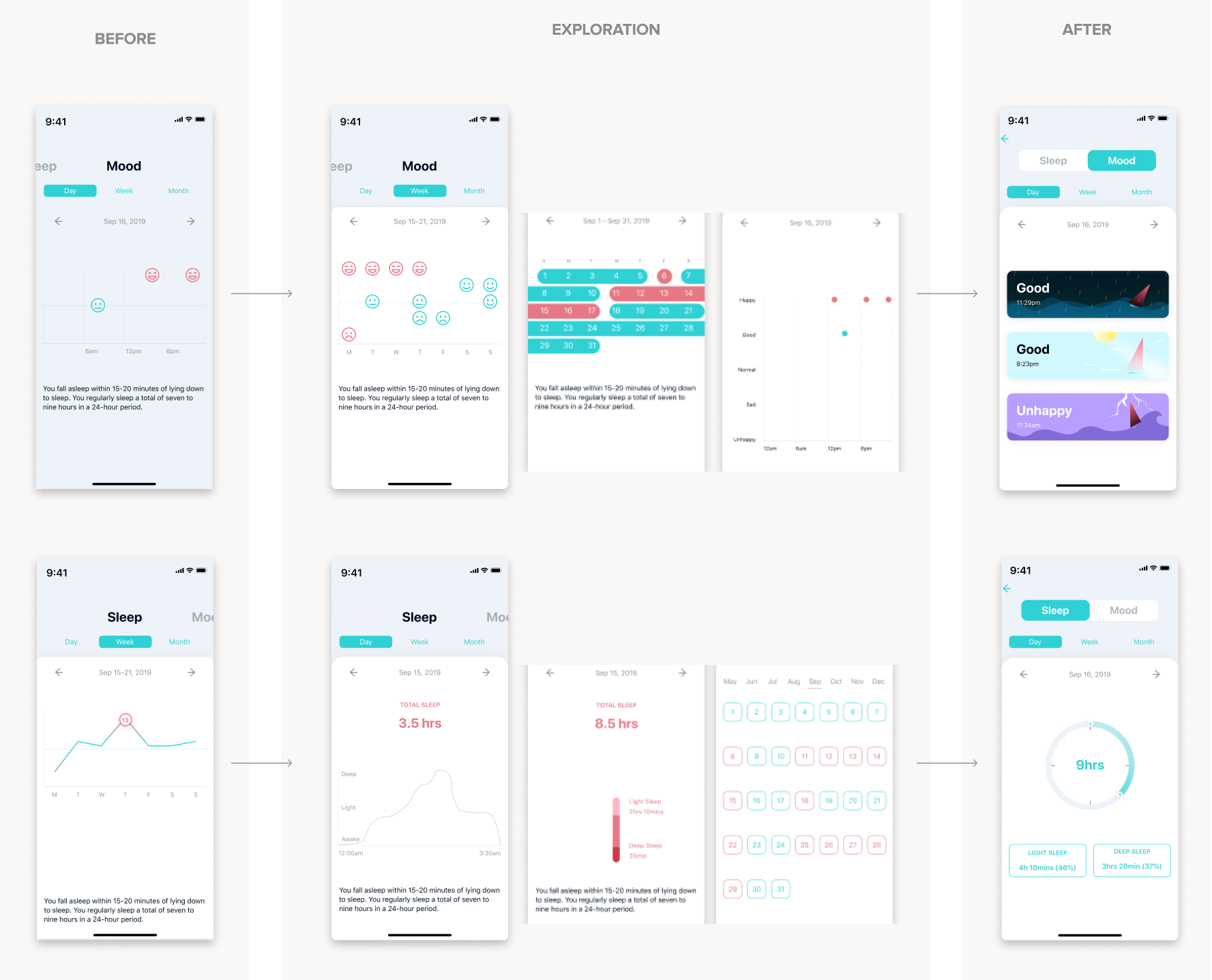
Final Concept
Sail is a suite of tools that involves a tracker wearable for the patient and a smartphone app for both the patient and the roommate. These tools work together to help patients document their health data using the wearable. The wearable will sync the data to the app to support the patient’s roommate to gain an informed understanding of the patient’s behavior. When roommates notice something goes off, they can use the information provided by the app to validate their concerns. In case of an emergency, the app will recommend a person for a roommate to contact for guidance.
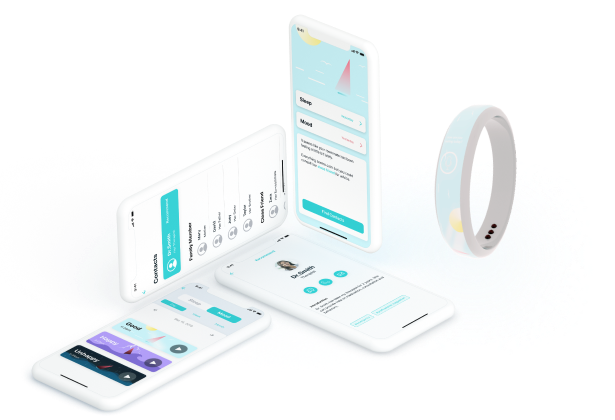
App Hifi Mockups
On-boarding
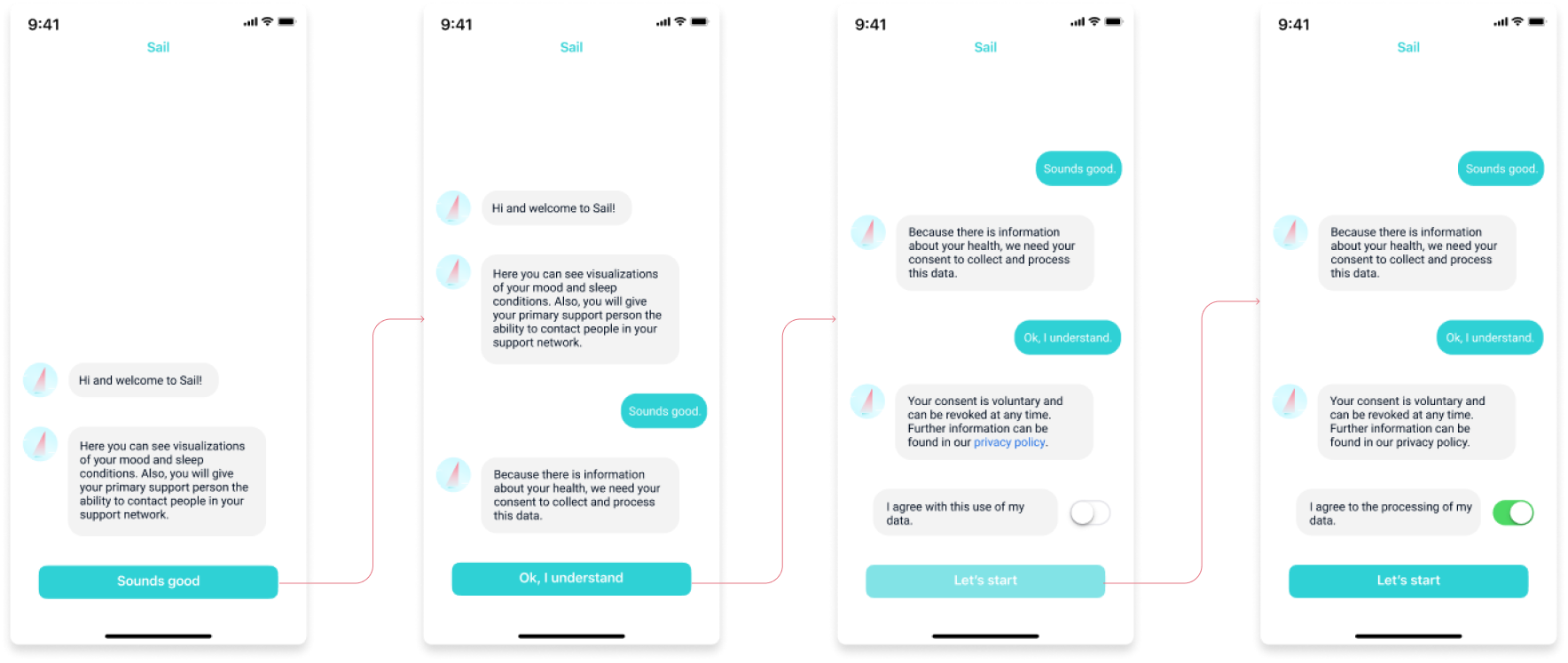
Creating Contact List
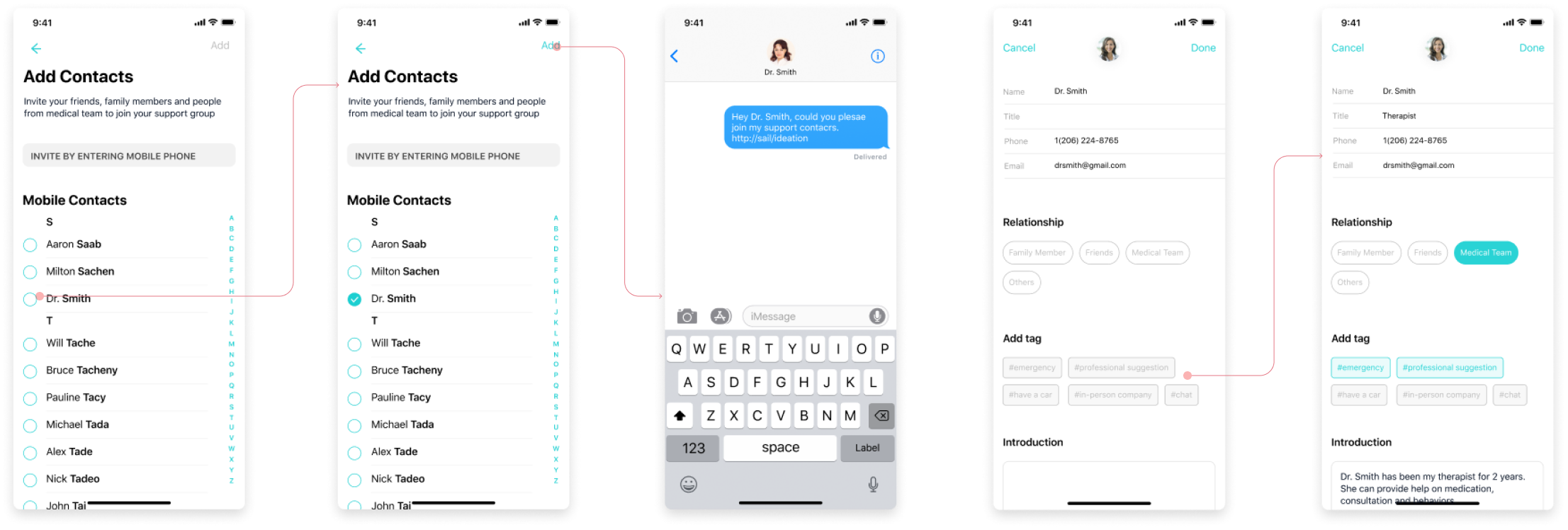
Logging Daily Mood Using Wearable
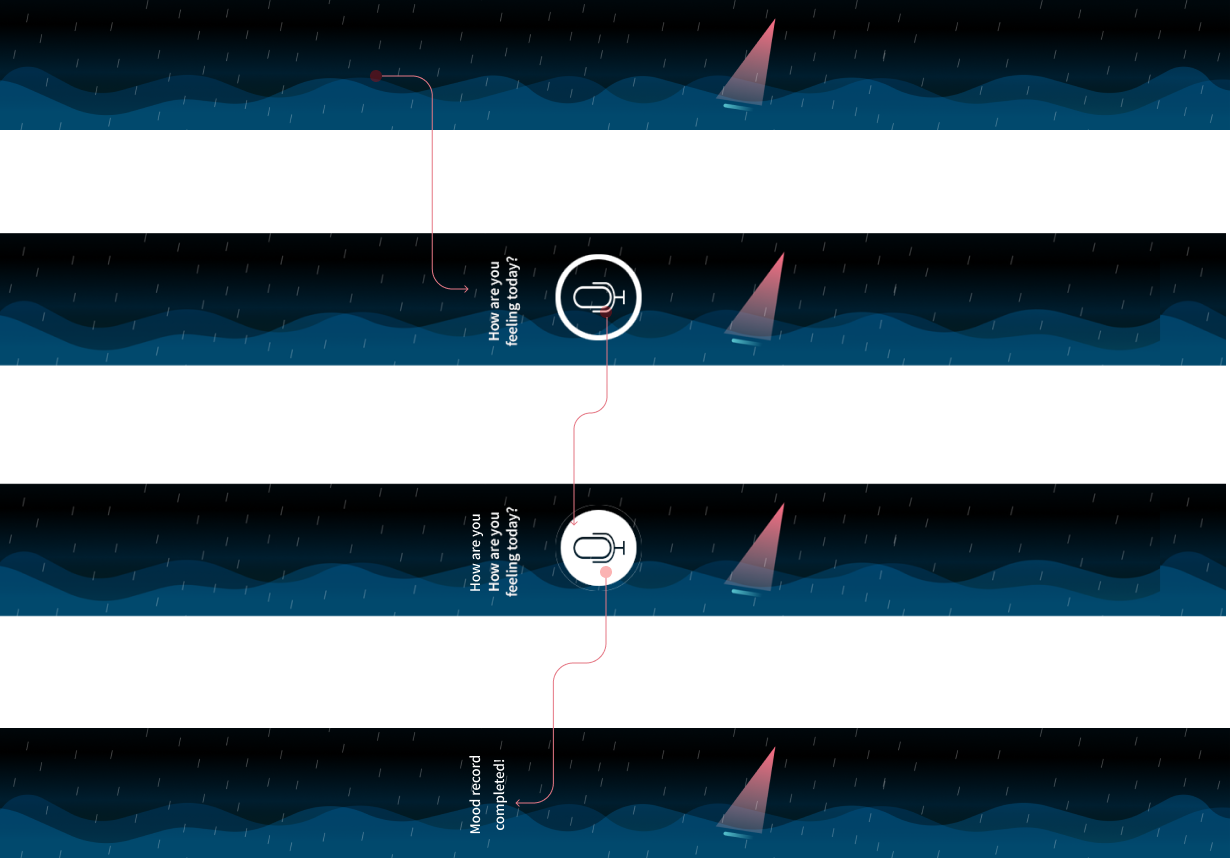
Checking Stability & Coordinate Support
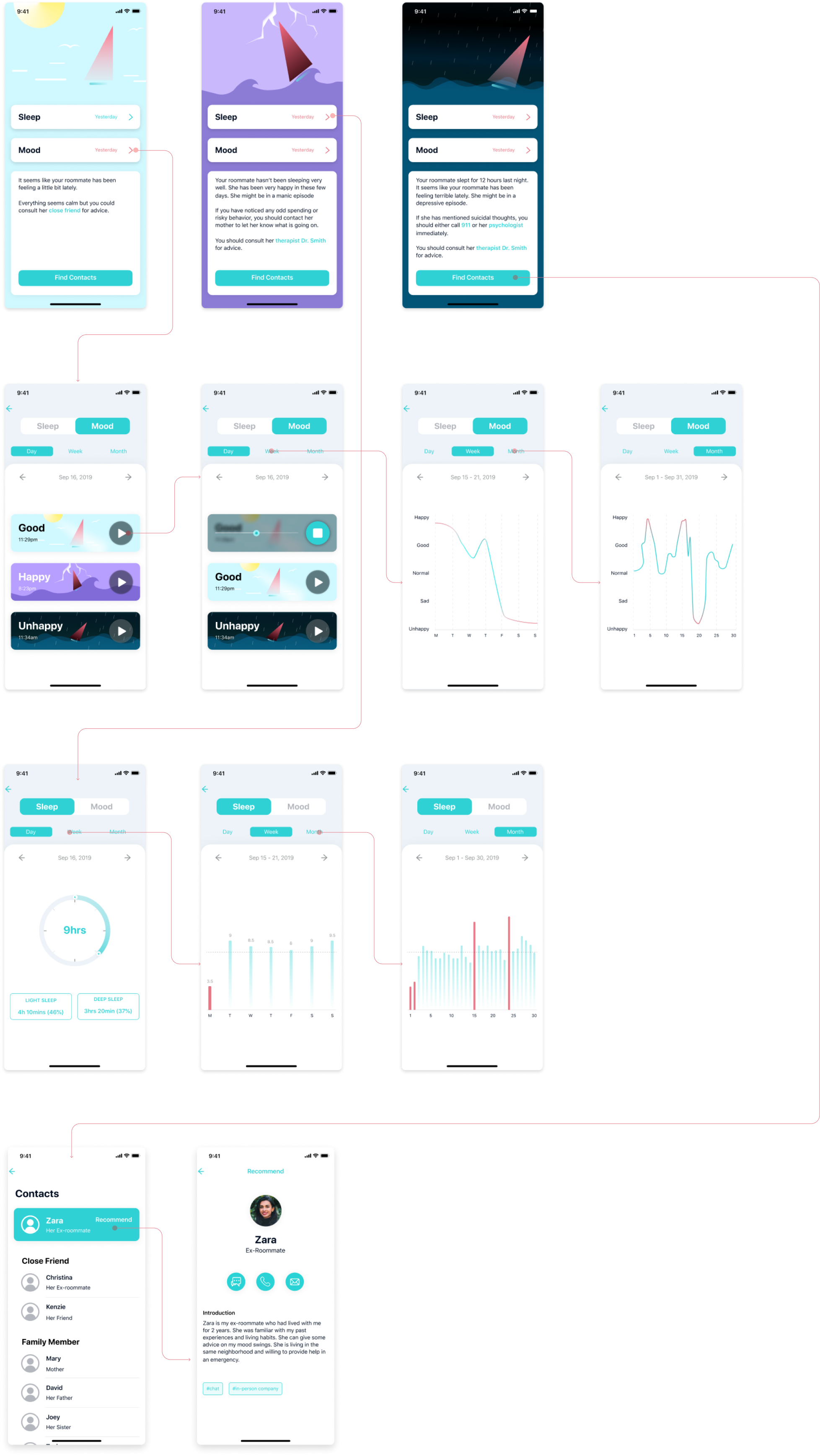
Result
We shared the Sail with one participant who has experience of living with an older family member with bipolar disorder. His feedback confirms that the final product really achieved our team’s desired outcomes.
“Having a tool that validated certain senses I had about the state of the patient would have been very helpful in decision making. And this is exactly what I need for me and my family.”
- A son whose father has bipolar disorder
Takeaway
Making people empathize with roommates of bipolar disorder patients was surprisingly difficult.
During the test, 99% of our participants say they will just move out and find a new place to live. They consider bipolar disorder patients as a stranger and not the one who is part of their life. Through the process of our research, we spoke to roommates of people with bipolar disorder, but we have come to define a roommate as anyone a patient could be living with. This person could be the patient's child, or partner or parent, or best friend. Each type of relationship comes with different levels of care but surprisingly, the same needs, which is we want to help and support patients and do not want to leave them alone. And that’s why I love this project so much.
© Harri Lin 2023


